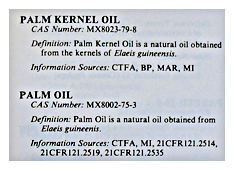The Code of Federal Regulations specifies where to find the names by which cosmetic ingredients should be identified in the ingredient declaration on a cosmetic. First are any names “established by the Commissioner” (there are a few) and then the CTFA Cosmetic Ingredient Dictionary, Second Ed., 1977.
After some searching, I was finally able to locate a copy of this elusive book ($200 from an online used book distributor). Now I’ll share what I found in the book.

The Second edition is a mere single volume with just 513 pages. For some comparison, the Fourteenth edition (2013) was 4 very fat volumes (see picture at top of page) and the Fifteenth edition (February 2014) looks to be even larger.
The parts of the book that are most pertinent to us are:
Monographs which cover defintions, structures, and other information for CTFA Adopted Names (350 pages) and
Chemical/Trade Names which cross-reference chemical terms, trademarks, generic names and common names to CTFA Adopted Names (110 pages).
NOTE: The “CTFA Adopted Names” are now the “International Nomenclature Cosmetic Ingredient” (or “INCI”) names.
Monographs
Key Words to Know
Monograph
A detailed written study of a single specialized subject or an aspect of it.
The monographs define what is meant by a particular ingredient name. Looking at the details of the monograph makes it very clear what the ingredient is. In the Second edition, plant-based ingredients (botanicals) are identified by their common name.

According to the publishers webiste, the current (2014) edition of the Cosmetic Ingredient Dictionary contains 21,000 monographs, which is considerably more than the Second Ed. from 1977. If you’re using an ingredient that isn’t in the Second Ed., the FDA has indicated that they will accept ingredients from later editions (although botanicals should still be listed by the common name).
NOTE: The Code of Federal Regulations lists a number of ingredient names that were NOT adopted from the Second Ed. of the CID. They are mostly Acid and Solvent colors (such as. “Acid Black 58” and “Solvent Brown 43”). There is also a list of ingredients that were adopted provisionally, pending revision of the monographs, which was done in subsequent editions of the CID.
Chemical/Trade Names
The second interesting section of the Second Ed. is the Chemcial/Trade Name section which cross-references chemical terms, trademarks, generic names and common names to the CTFA Adopted Names. The chemical and trade names are listed in alphabetical order on the left, with the CTFA adopted name listed on the right. Most of the time it’s pretty straightforward.
For example, ingredients with trade names of Tween 80 (from ICI United States), Emsorb 6900 (from Malmstrom Chemical Corp.) or GlycosperseO-20 (from Glyco Chemicals, Inc.) should all be listed with the CTFA adopted name of Polysorbate 80.
Where it gets a little more interesting is where the CFTA adopted name consists of several components.
For example, Preservatol (from Van Dyk & Company) shows a CTFA adopted name of “methylparaben (and) propylparaben (and) benzylparaben”.
In this case, while it LOOKS like the stated CTFA is what should go in the ingredient declaration, that would be incorrect, as explained (and documented) below).
1. Note on the Chemical/Trade Name Pages:
At the bottom of each page in the Chemical/Trade Names section, there is a note that says:
“In some instances the CTFA Adopted Name does not reflect all components present. See Important Regulatory Information on page xvii.”
2. Regulatory Information (Page xvii):
This section discusses ingredient labeling, and states:
“CTFA Adopted Names when applied to trade named ingredients identify the principal components in these materials. Occasionally other components such as diluents, solvents, preservatives, antioxidants and the like may be present in ingredients. When these components do not conform to the definition of ‘incidental ingredients’, they must be included in the ingredient listing on the label.”
3. Conventions Used in Chemical/Trade Names Section:
In the Introduction, Sub-section G. covers the conventions used in the Chemical/Trade Name sections of the book, and says:
“Terms in parentheses in the CTFA Adopted Names column are explanatory terms and are not meant to be included on labels.”
FDA’s Cosmetic Labeling Guide, Use of “(and)”
Following an example of the right and wrong ways to label a lipstick, the text points out one of the three common errors as:
“Proprietary mixtures of ingredients identified in the ingredient dictionary by a parenthetical “(and)” are often declared on the label as shown in the dictionary section listing chemical/trade names and their respective label names. The compounds of such mixtures must be separated, the “(and)” omitted, and the components treated as individual ingredients for labeling purposes.”
The Takeaway
This isn’t new information, it’s just a new way of looking at old information that’s still pertinent. Taking it back to the actual book that is referenced in the regulations, and seeing what IT says.
It also gives some clarification on how the INCI names have evolved, and how they were originally used. In the beginning, it was just the “adopted name.” Now it’s the International Nomenclature (in an attempt to standardize ingredient names internationally). Either way, it’s still the common name, and still listing components of a blended ingredient separately.
These details once again also reinforce the fact that just because the “INCI name” is “something (and) something (and) something,” it doesn’t mean that’s the way it’s supposed to be listed in the ingredient declaration. You still need to list the individual components in descending order of predominance based on the entire formulation.

Shameless plug!
To really be able to create your own labels that comply with the regulations, get my book from Amazon and use it.
4th Edition – Released March 5, 2025!!!
Or order directly from me (and get a signed copy)!


Leave a Reply